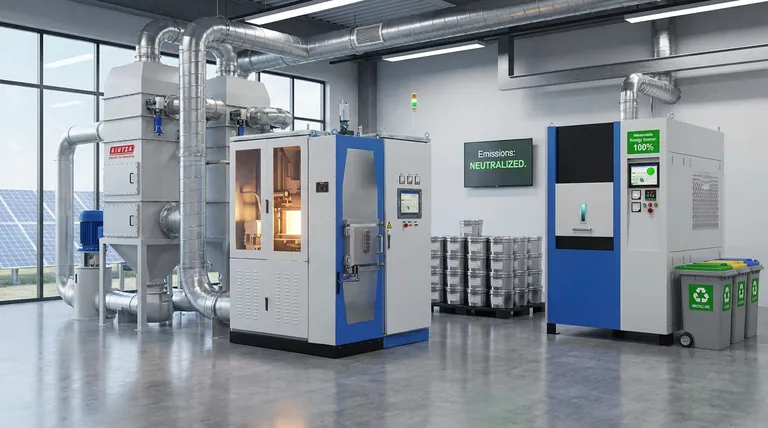In its traditional form, sintering is not an inherently environmentally friendly process. It is an energy-intensive manufacturing method that relies on extremely high temperatures to fuse materials together. This core requirement creates significant environmental challenges, primarily related to energy consumption and the potential for harmful emissions, leading to increased governmental regulation.
Sintering presents a classic environmental trade-off. While its high energy usage poses a significant challenge, its efficiency in minimizing material waste can make it a more sustainable choice than subtractive methods like machining, depending entirely on the application and energy source.

The Core Conflict: Heat, Energy, and Emissions
Sintering's environmental impact stems directly from its fundamental mechanism: applying immense heat to materials. Understanding this relationship is key to evaluating its sustainability.
The Problem of High Temperatures
Sintering works by heating powdered materials in a furnace to a temperature just below their melting point. This causes the individual particles to bond, creating a solid, dense part.
Achieving and maintaining these temperatures, which can exceed 1200°C (2200°F), requires a massive and continuous input of energy.
The Carbon Footprint of Energy Consumption
The primary environmental drawback of sintering is its high energy consumption. In most industrial settings, the furnaces that power this process are fueled by electricity or natural gas.
If this energy comes from fossil fuels, the sintering process carries a substantial carbon footprint from the associated CO2 emissions.
The Risk of Harmful Emissions
The reference correctly notes that sintering can release harmful emissions. During the heating process, binders, lubricants, or other agents mixed with the material powders are burned off.
This can release volatile organic compounds (VOCs) and other pollutants into the atmosphere if not properly captured and treated. This has led to the implementation of strict environmental policies controlling industrial emissions.
Sintering's Counter-Argument: Material Efficiency
Despite its energy demands, sintering has one profound environmental advantage over many other manufacturing techniques: it produces almost no waste.
A Near-Net-Shape Process
Sintering is considered a near-net-shape process. The initial powder is formed into the precise shape of the final part, and very little, if any, material is removed.
The Contrast with Subtractive Manufacturing
This stands in stark contrast to subtractive manufacturing, like machining, where a final part is carved out of a larger block of raw material. This process can generate a significant amount of scrap metal or plastic, which then needs to be collected, transported, and recycled—all energy-consuming steps.
For complex parts, the material saved by sintering can represent a major environmental and economic benefit, offsetting some of its high energy costs.
Understanding the Trade-offs
Choosing a manufacturing process requires balancing competing factors. The environmental friendliness of sintering is not a simple "yes" or "no" but depends on what you are comparing it against.
The Sintering vs. Machining Dilemma
The choice between sintering and machining is a perfect example of this trade-off. Machining may consume less direct thermal energy but wastes raw material. Sintering saves material but consumes vast amounts of energy for heating.
The "greener" choice depends on the part's geometry, the material's value, and the source of the energy used.
The Impact of Modern Mitigation
Modern sintering facilities can mitigate their environmental impact significantly. Innovations include:
- High-efficiency furnaces with better insulation and heat recovery systems.
- Emissions control systems (afterburners or scrubbers) to capture and neutralize harmful off-gassing.
- Powering furnaces with renewable energy, which dramatically reduces the process's carbon footprint.
Making the Right Choice for Your Goal
To assess if sintering aligns with your environmental goals, consider your primary objective.
- If your primary focus is minimizing material waste: Sintering is often a superior choice, especially for complex parts where machining would generate significant scrap.
- If your primary focus is reducing direct energy consumption: You must carefully evaluate the furnace technology and energy source, as traditional sintering remains highly energy-intensive.
- If your primary focus is regulatory compliance: Be prepared to invest in emissions control and monitoring, as policies for high-temperature processes are increasingly strict.
Ultimately, the environmental friendliness of sintering is not defined by the process itself, but by the conscious engineering and energy choices made to implement it.
Summary Table:
| Aspect | Environmental Impact | Key Consideration |
|---|---|---|
| Energy Use | High energy consumption from furnaces (>1200°C) | Major carbon footprint if powered by fossil fuels |
| Material Efficiency | Near-net-shape process minimizes waste | Superior to subtractive methods like machining |
| Emissions | Risk of VOC and pollutant release | Requires modern emissions control systems |
| Sustainability | Depends on energy source and technology | Renewable energy and efficient furnaces reduce impact |
Optimize your sintering process with KINTEK's advanced lab equipment!
Struggling to balance energy efficiency and material savings in your sintering operations? KINTEK specializes in high-performance furnaces and emissions control solutions tailored for laboratories. Our energy-efficient systems help you reduce your carbon footprint while maximizing material utilization—ensuring you meet both performance and sustainability goals.
Ready to enhance your lab's environmental profile? Contact our experts today to explore the right sintering solutions for your needs!
Visual Guide

Related Products
- Spark Plasma Sintering Furnace SPS Furnace
- Vacuum Heat Treat and Molybdenum Wire Sintering Furnace for Vacuum Sintering
- Vacuum Heat Treat and Sintering Furnace with 9MPa Air Pressure
- Laboratory Quartz Tube Furnace Tubular RTP Heating Furnace
- 600T Vacuum Induction Hot Press Furnace for Heat Treat and Sintering
People Also Ask
- What are the applications of spark plasma sintering? Fabricate High-Performance Materials with Precision
- What is spark plasma sintering of polymers? Rapidly Create Dense, High-Performance Materials
- What is the difference between spark plasma sintering and flash sintering? A Guide to Advanced Sintering Methods
- What are the uses of spark plasma sintering? Fast, Low-Temp Fabrication of Advanced Materials
- What is the mechanism of SPS? Unlock Rapid, Low-Temperature Densification



















